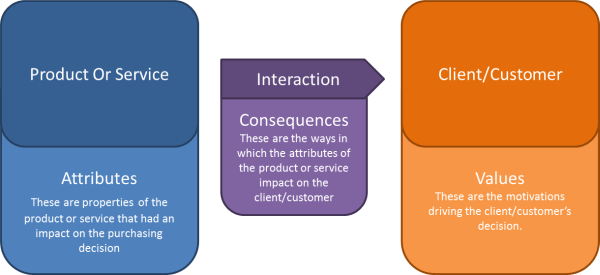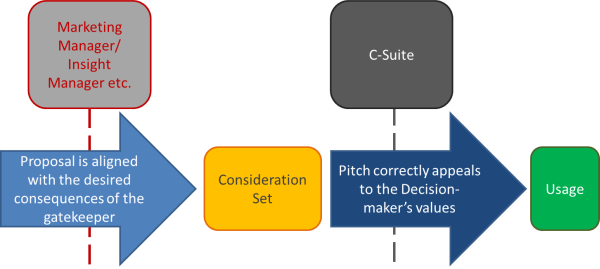A ladder is a tool designed to allow you to reach something otherwise unreachable. In the same way, “laddering” as applied to structured questioning is a technique designed to acquire nuggets of information which are otherwise very difficult to get at.
These hard to reach nuggets are of particular value when trying to understand purchasing decisions. Respondents in an interview will often struggle to articulate what led them to make a particular purchasing decision and so conventional methods will often only produce a very shallow understanding of what is going on. If we want to see further, we need a more structured approach.
Decision making and the Means End Chain
According to Means End Chain Theory, purchasing decisions are made based on a hierarchy of perceptions, and these relate to different levels of conscious consideration and different aspects of the interaction between the decision maker and the product or service. These are known as “Attributes”, “Consequences” and “Values”.
Attributes, consequences and values – components of the decision

Traditional questioning is fairly good at identifying the “attributes” influencing the decision, but will rarely give you the full list of “consequences” and is very ineffective at reaching the client/customer “values” which are central to their decision-making process.
A means to establish what people value
Laddering is a well-established technique from psychology and is typically used to encourage self-analysis of behavior and motivations. Applying this process to market research helps us to gather a more complete list of “consequences” and climb towards the hard-to-reach “values”. These “values” are the most useful tools for predicting behavior and identifying potential new opportunities.
The core of the laddering framework as applied to market research consists of the following series of questions:
-
“Why did you choose this product/service?” – to establish the important attributes
-
“Why is it good/bad that…?” – to establish the consequences of each attribute
-
“Why is this important to you/your business?” or “How does this relate to your core business values?” – to establish the values of the respondent which are affected by each consequence
The first question identifies the “attributes”, the second is asked about each attribute to identify that attribute’s “consequences”, and the third attempts to draw out the underlying business needs and motivations or “values” that these consequences impact upon.
Limitations of laddering
This is a proven technique in consumer studies but it has a number of drawbacks:
-
The number of questions which it generates can be large, and the process of repeatedly asking someone why can seem childish and boring. With this in mind it is essential that you explain the theory behind the technique to the respondent before beginning the questioning.
-
Answering the later questions can be difficult. Not everyone will be able to do so, and attempting to force an answer is counterproductive.
-
Recording responses can be complicated, so care should be taken in preparing for and conducting the questioning.
-
The technique is designed to help people examine their actions and experiences. It is not suitable for investigating hypothetical decisions; people will often find it difficult to answer and answers will be less reliable.
Applying laddering to B2B studies
Despite its limitations, this technique remains a powerful tool for unlocking the real drivers for things such as purchasing decisions in consumer research, but how well suited is it to business-to-business research?
The answer to this question depends somewhat on the complexity of the decision making unit. Essentially, while it does provide more detail than conventional open questioning, getting the full benefit from the technique requires separately questioning all principal participants in the decision process and having a good understanding of the dynamics of this process.
Who are the gatekeepers? Who makes the final decision? Without having answers to these questions we still won’t have a clear picture of what is going on.
Using the example of market research and the decision of which research company to commission for a project, we might construct a model something like this:
Navigating the decision process for market research commissioning

This is a fairly simple model but illustrates the potential for additional complexity often found in business decisions.
According to the model above, research companies who win plenty of pitches but seldom convert these pitches into actual contracts might be successfully addressing the desired consequences of the Insight Manager but falling short when it comes to appealing to the higher level business values of the C-Suite decision makers.
Conclusions
Laddering has the potential to reveal more about the underlying values which guide business decisions. However, where possible, these studies should be combined with a detailed mapping of the decision making unit and the process involved. The true value of the technique can seem unclear until you realize that in many important business decisions, the final choice is determined by how well the product or service targets the motivating values of the key decision makers.


